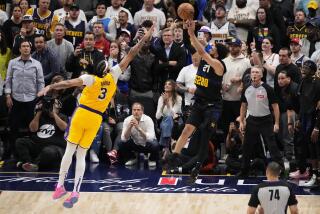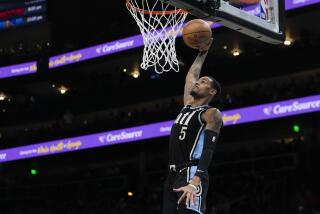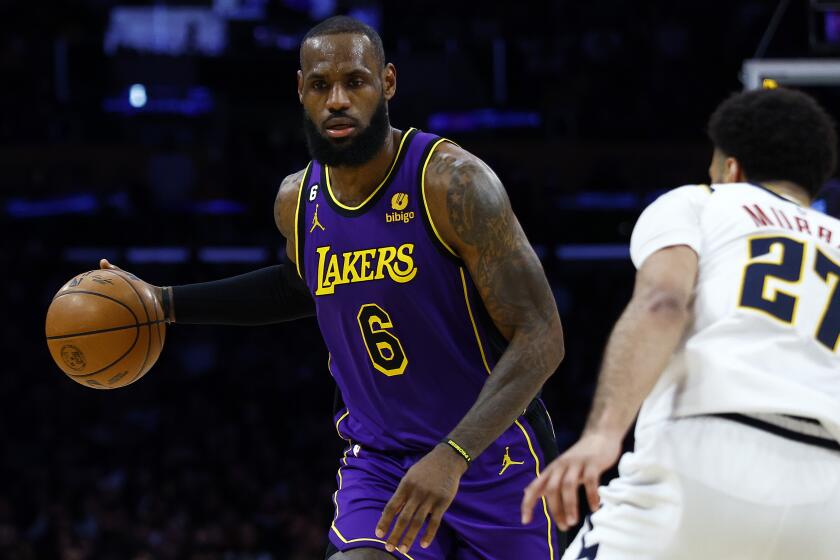Title teams and the crowds that love them
Last Wednesday, when the Lakers were leading the Orlando Magic by only two games to one in the best-of-seven NBA Finals, the Los Angeles Police Department wasted no time releasing possible dates for a team victory parade down Figueroa Street.
The presumptuous announcement didn’t jinx the Lakers; they could win the title tonight. But even if planning backfires -- with some council members in the cash-strapped city now balking at using taxpayer money to cover the estimated $1-million parade price tag -- it would be only one more wacky chapter in the history of local championship celebrations.
It’s a story that includes such elements as a gang of flight attendants surrounding Sandy Koufax; the sequestering of Lakers players for several minutes in City Hall; tree-climbing fans; and a player’s wild dance that caught the eye of the White House.
Partly because of early 20th century restrictions on the height of downtown buildings, ticker-tape parades never became a tradition in L.A. How much excitement can be generated by tossing confetti out a second-story window?
When the Rams captured their only world championship in L.A. on Dec. 23, 1951, there was no public celebration. Perhaps everyone had to run home to prepare for Christmas.
In 1959, when the Dodgers knocked off the Chicago White Sox to win their first World Series in L.A. (they won their only title in Brooklyn in 1955), the festivities were confined to Los Angeles International Airport.
As the arriving players were being introduced, The Times wrote, “the fans surged through a police line and swarmed onto the speakers’ platform to personally say a word to their favorite players or to pound them on the back.”
Pitcher Koufax “was quickly surrounded by 10 airline stewardesses as he emerged from the plane,” The Times said. He and some of the other Dodgers ran “to their cars in the parking lot to escape.”
Crowd control was even more of a problem in 1980, when the world champion Lakers paraded for the first time through downtown. Police supervision was minimal, and the fans were so boisterous outside City Hall that for their safety the players were kept inside “a hot, stuffy room” for more than an hour.
The players waved and quickly left -- and the crowd reacted unhappily. City Councilwoman Peggy Stevenson complained of having to fight “my way through this mob of hoods. That’s what they were, awful-looking people, acting terrible, making obscene remarks to all of us who were trying to get back to our offices.”
The Dodgers’ 1981 parade also turned a bit tense when the fans learned that star pitcher Fernando Valenzuela was absent.
County Supervisor Ed Edelman, his speech interrupted by cries of “We want Fernando!,” said plaintively, “I can’t give you Fernando.”
To the rescue came Tommy Lasorda, the fiery Dodgers manager, who faced down the crowd as he would a recalcitrant player: “Hold it!”
When the Lakers won another title in 1982, a new crowd-control tactic was used: Players and fans were separated by a wall of water-filled trash cans at City Hall. There would be no more pounding favorite players on the back.
Police spokesman Dan Cooke estimated there were 6,044 fans on the south lawn. “The 44 were in trees,” he added.
The squabbles between Los Angeles Raiders owner Al Davis and city officials over the use of the Coliseum spilled into the team’s lackluster 1984 Super Bowl celebration.
Several players were no-shows, and so was Davis, who had a “prior commitment.” The rest of the team was late, and when elected officials were introduced first, the fans booed loudly.
When the Dodgers triumphed in the 1988 World Series, the city had acted to handle the problem of would-be Tarzans. Workers daubed the trees at City Hall with white numbers, ranging from 1 to 34.
A city worker explained, “When somebody falls out and breaks an arm or a leg, the spotters will be able to say, ‘Go to tree so-and-so and rescue someone.’ ”
The City Council also christened the south landing at City Hall as the Plaza of Champions. After all, L.A. teams won eight world titles in the 1980s.
But, then for more than a decade, local teams went dry. The Lakers broke the ice in 2000 and repeated the next two years. Remember the “three-peat” chant? A good-natured bench warmer named Mark Madsen found himself in the spotlight in 2001.
During the festivities outside Staples Center, he broke into a strange herky-jerky dance that would have been more explicable, as one columnist wrote, if Madsen “were the star of a B-movie western and someone had just put a bullet in his leg.”
Later, when the team visited the White House, President Bush asked Madsen not to repeat the dance: “I’m afraid the Secret Service might react violently if you did.”
The Lakers, who seem to be the only L.A. team that wins world championships anymore (unless you count the geographically challenged Los Angeles Angels of Anaheim), prefer holding their victory parties at Staples these days. If they win, their parade will start at Staples and fast-break south to the Coliseum.
Meanwhile, the Plaza of Champions at City Hall is largely forgotten -- not even a plaque marks the site. Perhaps the plaza will come alive should the Dodgers end their World Series drought. If the Dodgers lack for inspiration, they should be reminded that the lonely City Hall trees are waiting, their painted numbers still visible.
--
steveharvey9@gmail.com
More to Read
All things Lakers, all the time.
Get all the Lakers news you need in Dan Woike's weekly newsletter.
You may occasionally receive promotional content from the Los Angeles Times.






